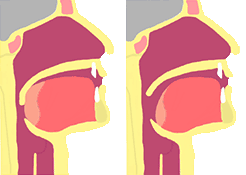ENT surgery
Laser surgical treatment of snoring / laryngeal surgery
Therapy
Through an age-related poor muscle tone in the soft palate and / or excess tonsil tissue in the throat or base of tongue, the air flow through the passage will cause any excess tissue to vibrate in the sleep causing the snoring sound. Also narrow points in the nasal cavity and nasopharyngeal space can cause snoring.
Thanks to super pulsed laser technology which is gentle to the tissue (also used for scarfree wrinkle treatment) and precision radio frequency thermal probes – especially developed for the ENT field – the muscle tone of the soft tissue in the pharynx will be improved. The tissue is gently heated up to 60 – 70 ° C using radio frequency and its volume is reduced through thermal coagulation.
The advantage compared to older methods is that burning and therefore excess scaring of tissue is avoided. Additionally, this method is almost painless and low in bleeding.
Depending on the location ascertained there are various treatment options or combinations of the following procedures:

Pharynx with slackened soft palate and enlarged tonsil – (left) prior to and (right) after radio frequency surgery of the soft palate and palatal tonsils
Soft palate-uvula plastic surgery by means of radio frequency and laser technology
The radio frequency therapy in the palatal area causes an improvement of the muscle tone of the soft palate. With super pulsed laser technology any excess mucous tissue in the uvula and palatal area is gently removed.
Palatal Tonsil-(partial-)removal by means of radio frequency and laser technology
Enlarged tonsillar tissue that causes a lateral restriction of the pharynx is gently thermally coagulated with radio frequency operated thermal probes and subsequently removed with super pulsed laser technology. The internal tonsillar tissue within the palatal arch remains in place. Since the capsular tissue surrounding the tonsil with a large number of blood vessels and nerves is preserved and is not affected, the disadvantages of a conventional tonsil operation (risk of postoperative bleeding, severe postoperative pain, loss of immune tissue of the tonsil) can be avoided.

Obstruction of airway through enlargement of lingual tonsil – (left) prior to and (right) after radio frequency treatment of lingual tonsil and soft palate
Radio frequency treatment of the base of tongue
Excessive lingual tonsil tissue pushes the epiglottis down und encourages the relaxed tongue muscle to drop back and block the airways while asleep. The thermal coagulating radio frequency treatment in the deep tissue of the base of tongue (the so-called lingual tonsil) which is low in pain receptors causes a considerable reduction of soft tissue and tightens it so that the risk of the tongue dropping back while asleep is lowered.
Radio frequency nasal concha reduction
Nasal conchas are downsized to their usual size through thermal treatment using precision radio frequency probes. This procedure does not have any impact on your life quality in the days following surgery. The surgical procedures – mostly done as day case procedure – will be carried out under general or local anaesthesia.
Microsurgical laryngeal surgery
Laryngeal surgery is principally done under general anaesthesia and in most cases with the aid of the CO2 laser.
Any hoarseness lasting longer than 3 weeks must be endoscopically examined by your ENT specialist.
Surgery methods and indications:
- Microscopic examination of unclear alteration of the vocal fold or larynx with tissue sampling, for example with any growth suspected to be cancerous
- Removal of polyps and cysts on vocal fold
- Removal of papilloma on larynx or vocal fold
- Treatment of the Reinke oedema (chronic flappy distension of mucous membrane)
- Microscopic-endoscopic removal of benign tumors or cysts at the base of tongue or back of throat area
- Removal of papules on vocal fold that are difficult to treat following overstraining of voice

